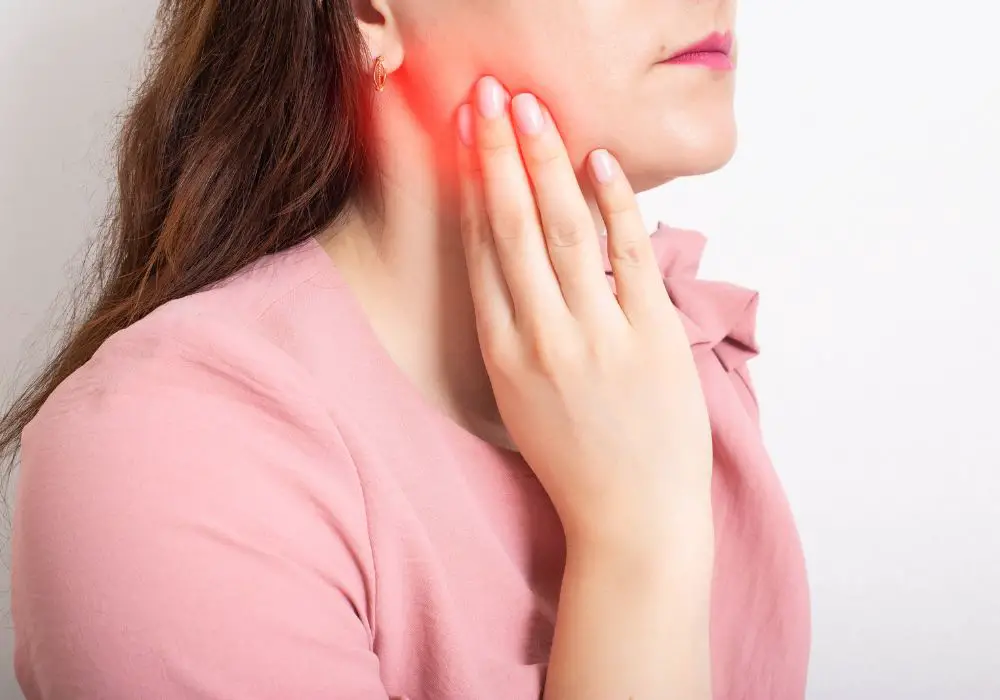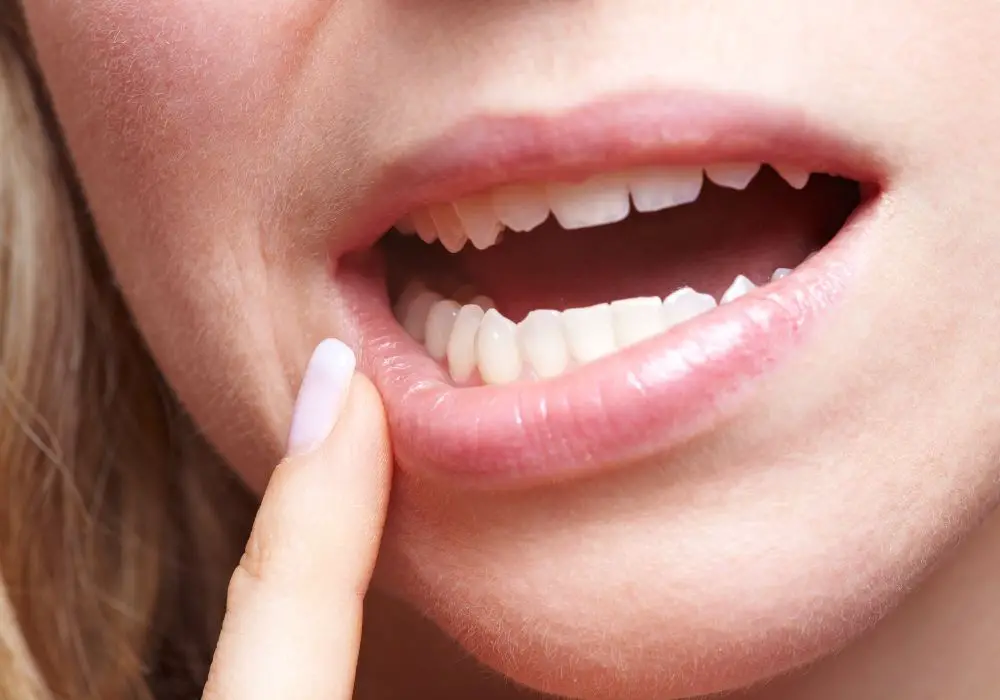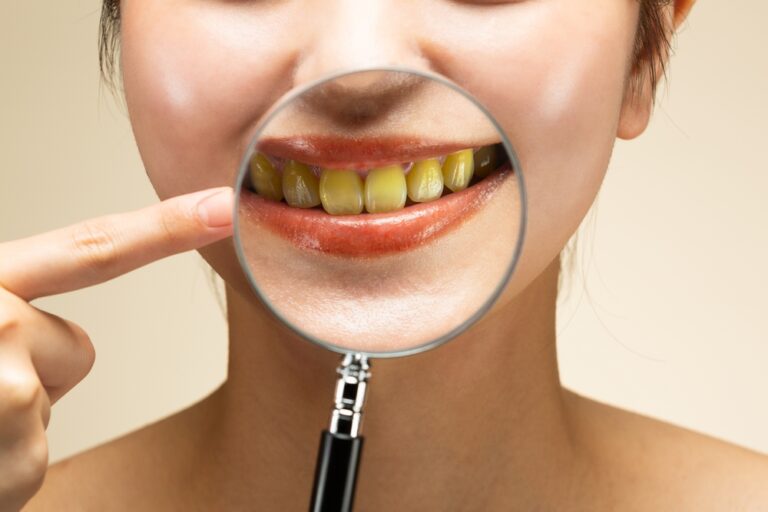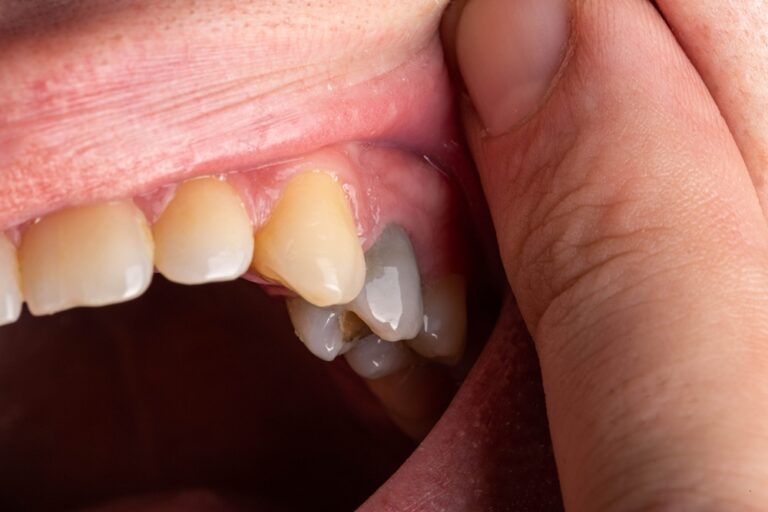Gum pain or soreness in the back of the mouth is a common complaint that can stem from various sources. The posterior molars are especially prone to plaque accumulation and inflammation of the gums known as gingivitis. However, gum discomfort can also arise from infection, ill-fitting dental work, trauma, or serious conditions like periodontal disease and oral cancer. Identifying the precise origin of gum soreness is key to proper treatment and relief.
Causes of Gum Pain in the Back of the Mouth

Gingivitis
Gingivitis is an early stage of gum disease caused by plaque buildup around teeth. When plaque hardened into tartar goes untreated, it harbors bacteria that release toxins. These irritants trigger inflammation and swelling of gum tissue.
As gingivitis worsens, gums redden, turn shiny, and bleed easily. Gum margins begin to pull away from teeth forming pockets that collect even more plaque. Patients typically complain of sensitivity, tenderness, and soreness when chewing.
Without treatment, gingivitis can advance to much more severe periodontitis and eventual tooth loss. The back molars near the opening of salivary ducts are particularly prone as their constant bathing in saliva promotes rapid plaque accumulation.
Periodontitis
Periodontitis is a progressive form of gum disease where inflammation has spread to deeper tissues and jawbone surrounding teeth. The gums recede further, pockets deepen, and bacteria begin degrading the periodontal ligaments and bone. Teeth loosen and become unstable.
Periodontitis sufferers experience pronounced soreness, bleeding, gaps between teeth, bad breath, and even alteration of bite alignment. Aggressive periodontitis tends to strike otherwise healthy patients under age 35. But chronic periodontitis is most common in those over 40.
If left unchecked, periodontitis destroys more bone until teeth become loose and fall out. Molars in the back are often lost prematurely. Professional deep cleanings, antibiotics, and gum grafts are required to halt damage and restore gum health.
Canker Sores
Canker sores manifest as round white ulcers inside the mouth surrounded by a red halo. They can develop along the gums in the back of the mouth near molars. Canker sores cause a burning, tingling pain.
While the exact cause is unknown, canker sores are triggered by stress, hormonal shifts, vitamin deficiencies, spicy foods, and mouth trauma. They usually heal on their own within 7-10 days. More severe cases may be treated by dentists with topical numbing agents, steroids, or cauterizing chemicals to ease discomfort.
Oral Thrush
Oral thrush results when the yeast Candida albicans proliferates inside the mouth and on gum tissue. It produces creamy white lesions and patches that cause soreness and bleeding when scraped. Thrush commonly affects the gums and palate but can spread to the back molars.
Denture wearers are very prone as the yeast overgrows on poorly fitting dentures. Other risk factors for thrush include diabetes, antibiotic use, smoking, steroid inhalers, vitamin deficiencies, and HIV/AIDS. Prescription antifungal rinses or lozenges can clear up most cases.
Ill-Fitting Dental Work
Crowns, fillings, bridges, braces, and dentures that do not properly fit can rub and irritate gum tissue. Constant abrasion causes swelling, sores, and discomfort concentrated along the band of gums contacting the dental materials. Misaligned or overhanging dental work frequently affects the gums around back molars.
Dentists can adjust fittings or re-cement loose dental work to prevent further irritation. Switching to denture adhesives may also relieve sore spots. In some cases, a full re-fabrication is required to correctly size dental appliances.
Trauma and Irritation
Any repeated irritation and trauma to the gums near molars provokes localized pain and inflammation. Common irritants include:
- Accidentally biting cheek or gums with molars during chewing
- Rough edges of dental fillings or crowns scraping gums
- Constant picking at gums with fingers or objects
- Chewing on hard items like ice or popcorn kernels
- Poking gums with toothpicks, fish bones, or other sharp debris
- Chemical or thermal burns from hot drinks, smoking, or acidic foods
Managing diet and habits to protect delicate back gum areas helps them heal. Dentists can smooth sharp dental edges or deliver fast pain relief with topical analgesics and steroids.
Oral Cancer
Persistent swollen lump, sore, or ulcer on the gums that does not heal could signal the presence of oral cancer. Oral squamous cell carcinoma accounts for over 90% of mouth cancers detected. Early warning signs often appear along the posterior gumline where cheek tissues meet the upper and lower molars.
Any strange lesion on the gums lasting longer than 2 weeks must be evaluated promptly by an oral surgeon. Other oral cancer symptoms include numbness, difficulty swallowing or chewing, earaches, and loose teeth. Successful treatment and survival are vastly improved when oral cancer is diagnosed at an early stage.
Less Common Causes
Other less frequent sources of back gum soreness include:
- Abscesses – bacterial infections forming pus-filled pockets in the gums requiring drainage
- Desquamative gingivitis – chronic inflammatory gum condition causing redness, burning, and peeling
- Leukemia – cancer of blood-forming tissues that can manifest with swollen, painful gums
- Vitamin C deficiency – causes weakened collagen and bleeding gums
- Pregnancy gingivitis – hormonal shifts during pregnancy aggravate swelling and inflammation
Getting Relief from Sore Gums
Here are some simple self-care tips to alleviate mild gum pain and discomfort:
- Gently brush sore areas using ultrasoft bristles and limited pressure
- Rinse mouth with warm salt water to flush away irritants and reduce inflammation
- Apply cold compresses to external gums to constrict blood vessels and ease swelling
- Take over-the-counter pain relievers like ibuprofen, naproxen, or acetaminophen for relief
- Avoid foods and habits that aggravate pain such as spicy foods, alcohol, smoking, ice chewing
Topical numbing gels containing lidocaine or benzocaine can temporarily numb severe gum pain for several hours. But caution should be used to avoid spreading infection deeper or masking a serious underlying condition.
For cases of persistent soreness and recognized gum disease, professional dental treatment is required for true relief and lasting repair of damage.
When to See Your Dentist Urgently

You should arrange an urgent dental visit if you experience any of the following:
- Severe constant gum pain unrelieved by normal OTC pain medications
- Sudden gum swelling, bleeding, or pus discharge
- White/red patches, blisters, growths, or lesions on gums
- Recurring gum pain concentrated in one area
- Loose teeth or changes in bite alignment
- Sensitivity to hot/cold foods and drinks
- Extreme sensitivity when brushing or chewing
- Foul persistent bad breath or taste
Do not delay in seeing a dentist when you have pronounced gum discomfort, sensitivity, or bleeding that persists longer than 1-2 weeks. This requires professional diagnosis and treatment to prevent extensive permanent damage.
Diagnosing the Underlying Cause
Dentists use several diagnostic techniques to pinpoint the origin of your gum pain:
- Reviewing medical and dental history plus symptoms
- Visual clinical oral examination checking for swelling, pockets, recession
- Probing and measuring pocket depth around each tooth
- Palpating gum tissue and noting pain response
- Testing tooth sensitivity and mobility
- X-rays to check for bone loss under gums
- Oral cancer screening looking for abnormalities
- Swabbing or culturing plaque samples
- Biopsy of tissue for microscopic examination
Based on these comprehensive findings, your dentist can determine whether gingivitis, cancer, infection, or some other issue is causing your discomfort.
Possible Complications of Untreated Gum Soreness
It is crucial not to ignore persistent gum soreness or self-medicate it without determining the underlying problem. Potential risks if gum pain goes unchecked include:
- Plaque and tartar continuing to penetrate deep below gumline
- Progressive permanent destruction of jawbone and periodontal ligaments
- Formation of bacterial abscess requiring surgical drainage
- Increased susceptibility to tooth decay and cavities
- Eventual tooth loss as infection spreads
- Cysts or benign growths on gums necessitating removal
- Oral cancerous lesions spreading deeper and metastasizing
- Bacteria and inflammation spreading to the bloodstream and causing systemic illness
- Facial swelling and severe pain from advancing infection
Attending promptly to any gum discomfort can halt damage early and prevent dangerous complications.
Typical Treatment Options

The appropriate treatments for sore inflamed gums depends on the diagnosed cause:
Gingivitis/Periodontitis:
- Professional dental cleaning to remove plaque and calculus
- Antimicrobial mouthwashes like chlorhexidine to reduce harmful bacteria
- Antibiotics taken orally or placed directly in periodontal pockets
- Deep cleanings below the gumline via scaling and root planing
- Gum grafts and regeneration procedures to regrow lost gum tissue
- Ongoing periodontal maintenance every 3-4 months
Canker Sores:
- Topical ointments, gels, or rinses to numb pain and inflammation
- Oral rinses containing dexamethasone, hyaluronate, lidocaine
- Tissue-bonding agents to shield ulcers while healing
- Nutritional supplements to boost immunity and healing
- For severe cases – steroid injections, silver nitrate, laser treatments
Oral Thrush:
- Antifungal prescription lozenges, rinses, tablets to clear yeast overgrowth
- Removal and sterilization of dentures
- Treatment of any underlying illness like diabetes or immunodeficiency
Denture Irritation:
- Adjustment and realignment of dentures
- Denture adhesives, cushions, or soft reline materials
- Implant-supported dentures to better distribute chewing forces
Trauma/Irritation:
- Nightguards and bite plates to prevent biting injuries
- Smoothing oversharp dental work edges
- Saltwater rinses to cleanse debris from wounds
- Topical anesthetics, steroids, antibiotics to control pain and infection
Oral Cancer:
- Biopsy for definitive diagnosis
- Surgical excision of malignant tissues
- Radiation, chemotherapy, or biologic drug therapy to eradicate cancer cells
- Rigorous follow-up visits to monitor for recurrence
With appropriate treatment guided by proper diagnosis, most causes of gum soreness can be fully resolved and future recurrence prevented through vigilant daily oral hygiene.
Frequently Asked Questions
What does healthy gum tissue look and feel like?
Healthy gums are pink, stippled, knife-edged in shape, and firm. They should hug each tooth snugly with no swelling or pulling away. Healthy gums feel resilient and do not hurt when brushed or flossed.
Can gum disease develop without pain?
Yes, gingivitis and periodontitis can initially progress with no soreness. Silent early gum disease only shows redness, swelling, and bleeding when probed. That’s why regular dental cleanings are vital for early detection and treatment.
Is constant gum pain normal with braces?
Some mild soreness is expected after braces are adjusted as the teeth shift. But pronounced constant gum pain is not normal and may signal infection or excess friction from wires. See your orthodontist promptly if gum pain persists over several days.
What home remedies soothe sore gums?
Salt water rinses, cold compresses, OTC pain gels, aloe vera, avoiding irritants, and taking anti-inflammatories can temporarily relieve sore gum discomfort before seeing a dentist.
When is gum pain an emergency?
Seek emergency dental care if you have severe throbbing pain, large swelling, uncontrolled bleeding, pus discharge, loss of feeling in gums or face, high fever, or trouble breathing or swallowing. These signal a dental abscess or serious infection requiring urgent attention.






